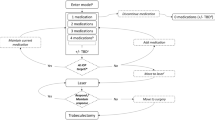Abstract
·Background: Economic evaluation of new treatments in the field of glaucoma represents a challenge. In the absence of a clear epidemiological link between intra-ocular pressure (IOP) and disease progression to blindness, the economic impact of treatments that lower IOP on long-term outcome cannot be estimated. As an alternative, effectiveness may be expressed as the ability to control IOP over time, making it possible to estimate the cost-effectiveness of therapies. The objective of this study was to investigate treatment strategies for patients newly diagnosed with primary open-angle glaucoma (POAG) or ocular hypertension (OH) in Germany and to estimate the impact of new topical therapies on the total cost of treatment. ·Methods: We performed a retrospective analysis of 200 randomly selected patient charts in 50 ophthalmology practices. Demographics, diagnoses, IOP and detailed resource utilization over 2 years were collected. Resources were valued independently from the quantitative data collection, and a standard charge from the perspective of the third party payer, as well as a cost from the societal viewpoint, was determined for each item. A Markov model was created to calculate total treatment costs with the new therapy. ·Result: During the 2 years, 54% of patients had their therapy changed at least once. Mean total charge and cost per patient were DM 815 and DM 1274, respectively. Mean IOP at baseline was 31.2 mm at baseline and 18.8 mm after 2 years. IOP at baseline was positively correlated with costs, while IOP reduction after treatment initiation was negatively correlated with costs. Simulations of the effect of new topical therapies on treatment costs to third party payers and to society indicate that a potential reduction or delay of surgical interventions may partly offset the extra cost of the new drugs. ·Conclusion: Observational data for glaucoma treatment indicate a high frequency of treatment changes that are associated with higher costs. New treatments that control IOP effectively over time may thus reduce the cost of patient management. Their cost-effectiveness for managing IOP will depend on both, their price and their effectiveness.
Similar content being viewed by others
Author information
Authors and Affiliations
Additional information
Received: 25 February 1998 Revised version received: 23 June 1998 Accepted: 29 June 1998
Rights and permissions
About this article
Cite this article
Kobelt, G., Jönsson, L., Gerdtham, U. et al. Direct costs of glaucoma management following initiation of medical therapy . Graefe's Arch Clin Exp Ophthalmol 236, 811–821 (1998). https://doi.org/10.1007/s004170050165
Issue Date:
DOI: https://doi.org/10.1007/s004170050165




